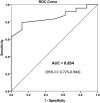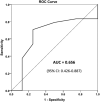Factors Impacting Stone-Free Rate After Retrograde Intrarenal Surgery for Calyceal Diverticular Calculi
- PMID: 32903933
- PMCID: PMC7445516
- DOI: 10.2147/RRU.S265959
Factors Impacting Stone-Free Rate After Retrograde Intrarenal Surgery for Calyceal Diverticular Calculi
Abstract
Objective: To evaluate the outcomes of retrograde intrarenal surgery (RIRS) treatment of calyceal diverticular calculi and identify the associated factors affecting post-operative stone-free rate.
Materials and methods: From August 2015 to May 2019, data of 32 patients with calyceal diverticular calculi who were treated by RIRS in a Siriraj Hospital were retrospectively studied. All operations were performed by the same surgeon using flexible ureterorenoscopy (f-URS) and holmium YAG laser lithotripsy. Calyceal diverticula were identified by our refluxing technique and from the collected demographic, diverticular and stone data. Operative outcomes were retrospectively evaluated. Data were analysed to identify the factors associated with stone-free outcomes. Stone-free was defined as no residual stones remaining after surgery.
Results: Mean age of the patients was 55.7 years. Stone locations were non-lower pole in 81.2% of cases and lower pole for the remaining 18.8% of cases. Median stone size was 1.2 cm with three as the median number of stones per patient. Calcium oxalate was the most common stone composition (56.3%). Positions of the diverticulum were anterior calyx (34.4%) and posterior calyx (50%), while the remainder were undetermined (incomplete data). Average length of the diverticular neck was 0.4 cm. Mean operative time was 46 minutes and mean hospital stay was 2.9 days. Complications included fever in three patients (9.3%) and sepsis in two patients (6.3%), with overall post-operative stone-free rate at 75%. Factors significantly affecting stone-free status were stone size (P=0.003) and length of diverticular neck (P=0.038). Multivariate analysis determined that only stone size had a statistically significant effect on post-operative stone-free status (P=0.015). Cut off point for stone size that increased the chances of a post-operative stone-free outcome was less than 1.5 cm, as determined by the ROC curve.
Conclusion: RIRS was found to be an effective and safe treatment option for the removal of calyceal diverticular calculi. Stone size of less than 1.5 cm offered a better chance of post-operative stone-free condition.
Keywords: calyceal diverticular calculi; endoscopy; retrograde intrarenal surgery.
© 2020 Boonyapalanant et al.
Conflict of interest statement
The authors report no conflicts of interest in this work.
Figures





Similar articles
-
Efficacy of flexible ureterorenoscopy with holmium laser in the management of calyceal diverticular calculi.Urolithiasis. 2024 Mar 30;52(1):50. doi: 10.1007/s00240-024-01552-9. Urolithiasis. 2024. PMID: 38554174 Free PMC article.
-
Could "Retrograde Intrarenal Surgery" be Used as an Efficient Technique in the Treatment of Calyceal Diverticula Stones.J Coll Physicians Surg Pak. 2022 May;32(5):623-626. doi: 10.29271/jcpsp.2022.05.623. J Coll Physicians Surg Pak. 2022. PMID: 35546699
-
[Management of calyceal diverticular calculi with stenotic infundibulum by flexible ureteroscopic holmium laser infundibulectomy and lithotripsy].Beijing Da Xue Xue Bao Yi Xue Ban. 2015 Aug 18;47(4):618-21. Beijing Da Xue Xue Bao Yi Xue Ban. 2015. PMID: 26284397 Chinese.
-
The best treatment approach for lower calyceal stones ≤20 mm in maximal diameter: mini percutaneous nephrolithotripsy, retrograde intrarenal surgery or shock wave lithotripsy. A systematic review and meta-analysis of the literature conducted by the European Section of Uro-Technology and Young Academic Urologists.Minerva Urol Nephrol. 2021 Dec;73(6):711-723. doi: 10.23736/S2724-6051.21.04388-3. Epub 2021 Jun 22. Minerva Urol Nephrol. 2021. PMID: 34156200
-
Calyceal diverticula: a comprehensive review.Rev Urol. 2014;16(1):29-43. Rev Urol. 2014. PMID: 24791153 Free PMC article. Review.
Cited by
-
[Comparison of long-term outcomes in different managements of diverticular neck in percutaneous nephrolithotomy for diverticular calculi].Beijing Da Xue Xue Bao Yi Xue Ban. 2021 Aug 18;53(4):704-709. doi: 10.19723/j.issn.1671-167X.2021.04.014. Beijing Da Xue Xue Bao Yi Xue Ban. 2021. PMID: 34393232 Free PMC article. Chinese.
-
Clinical advantages of suctioning flexible ureteroscopy with intelligent pressure control on treating large upper urinary tract calculi.Front Surg. 2025 Jul 2;12:1554964. doi: 10.3389/fsurg.2025.1554964. eCollection 2025. Front Surg. 2025. PMID: 40672442 Free PMC article.
-
Efficacy of flexible ureterorenoscopy with holmium laser in the management of calyceal diverticular calculi.Urolithiasis. 2024 Mar 30;52(1):50. doi: 10.1007/s00240-024-01552-9. Urolithiasis. 2024. PMID: 38554174 Free PMC article.
References
LinkOut - more resources
Full Text Sources

